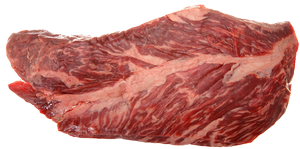
BUTCHER'S STEAK
This V-shaped detail is located deep in the midriff and holds the lungs and diaphragm of the animal in place. It has to work hard and has a rich, delicious meat taste.
Keep in mind
Also known as "Hanger Steak" and "Skirt". The name comes from an old tradition – or belief – that the butcher would often keep this cut for him- or herself. The French name is “onglet”. Yet another English name is “hanging tender”.
How to cook butcher's steak
Fry or grill quickly applying intensive heat. A Butcher's Steak in one piece should be cut in two along the large tendon before you fry/grill the flat pieces whole.
Butcher's Steak must not be cooked through, or it will turn very tough and dry. Aim for rare or medium and give the meat time to rest before serving.
The meat must be cut across the fibersin order to be easy to chew and tasty. It is recommended that you cut thin, appetizing slices for the guests so that you can make sure that the tasty meat is experienced in the right way.
Butcher’s steak is highly appreciated because it has a rich taste that resembles liver (which is said to be because it holds the animal's intestines in place). Others say that the taste of liver only is detectable if the steak is overcooked.
The classic
Roasted whole and served the French way with French fries and a sauce made of shallots, brandy, red wine and broth. Or grilled fast and hard and served with lime, guacamole, salsa roja and tortillas as in Mexico.








